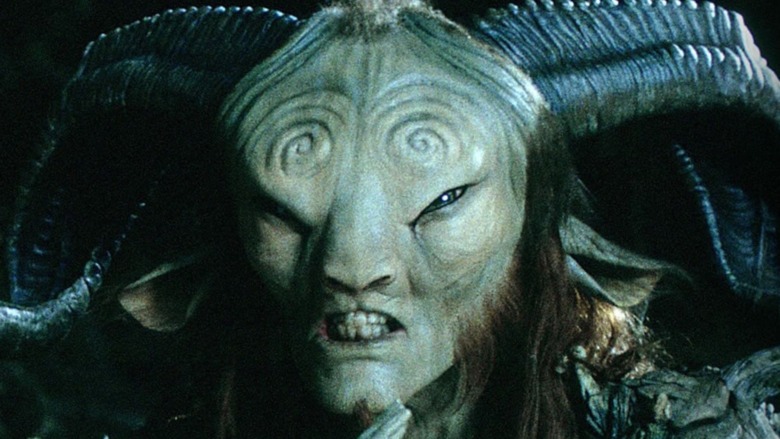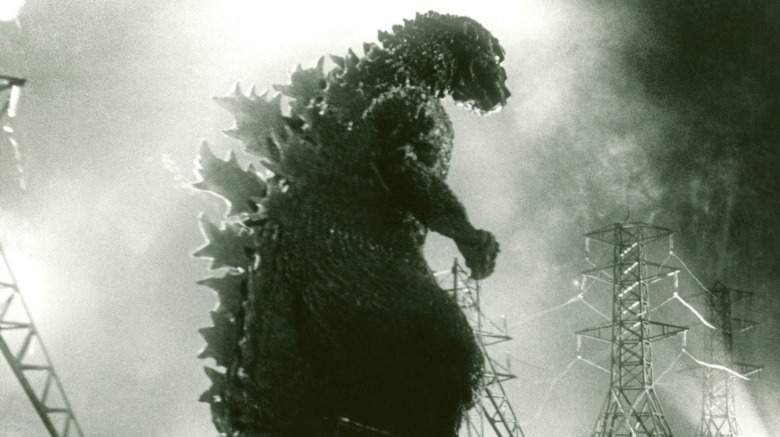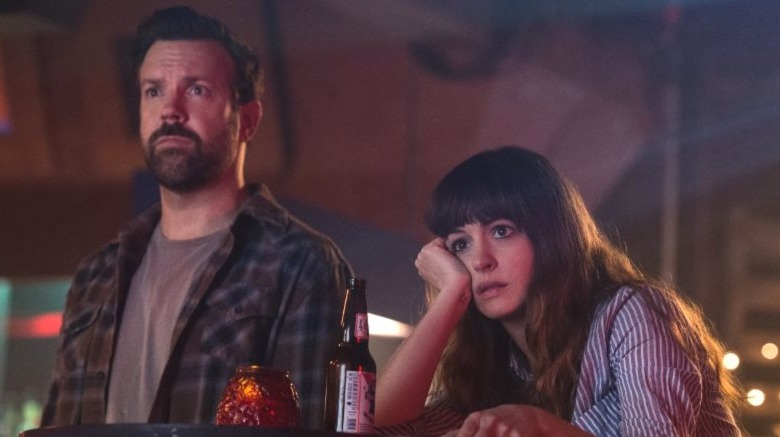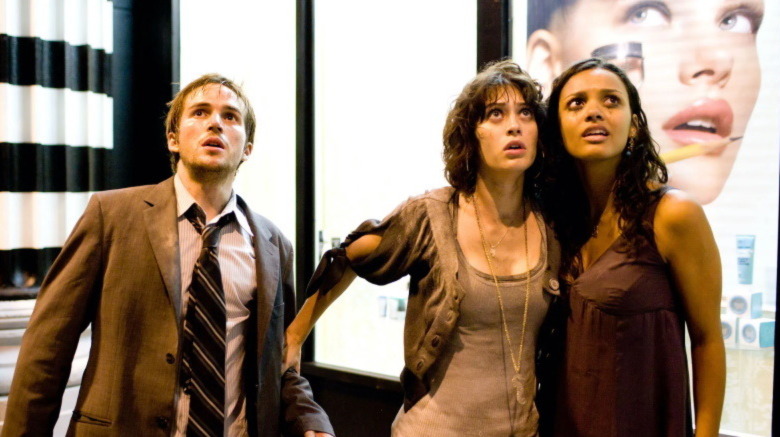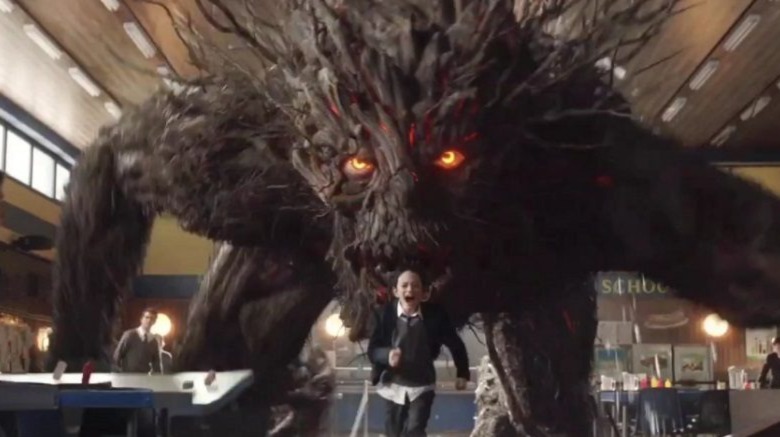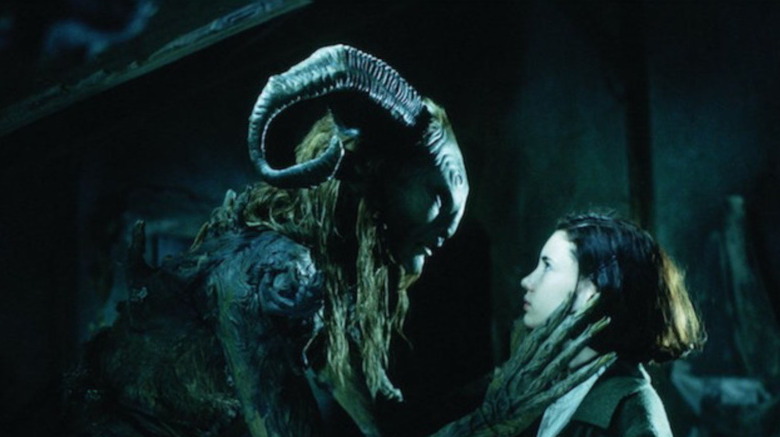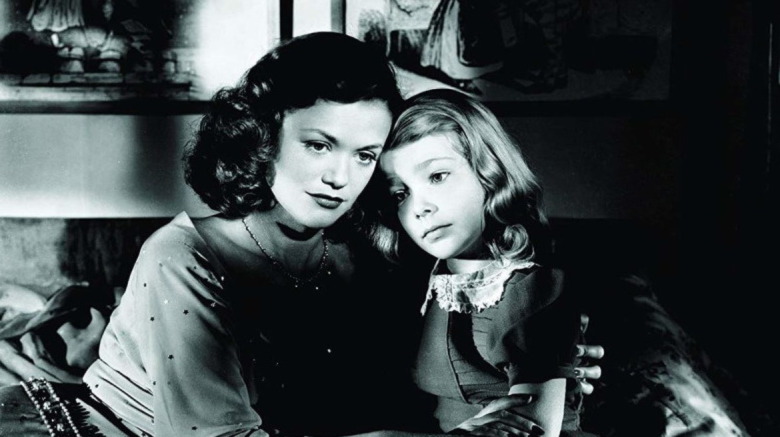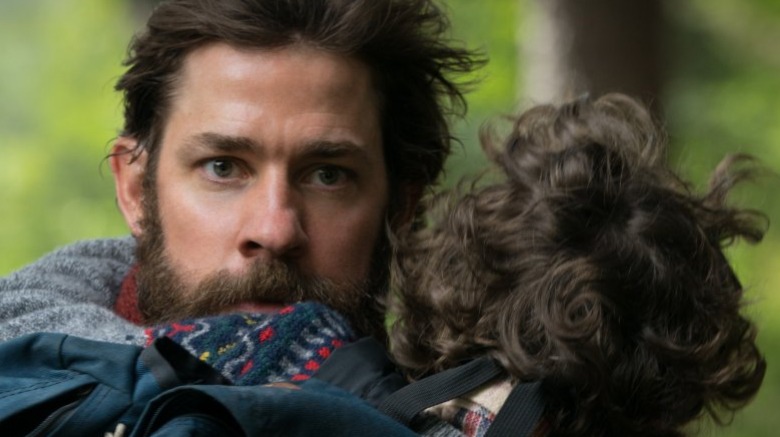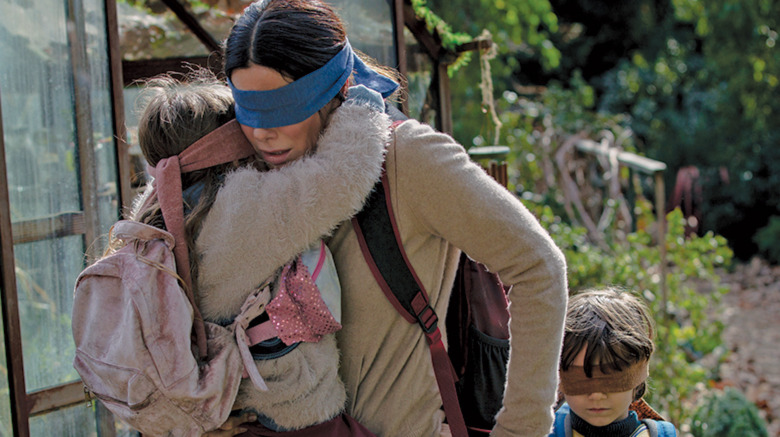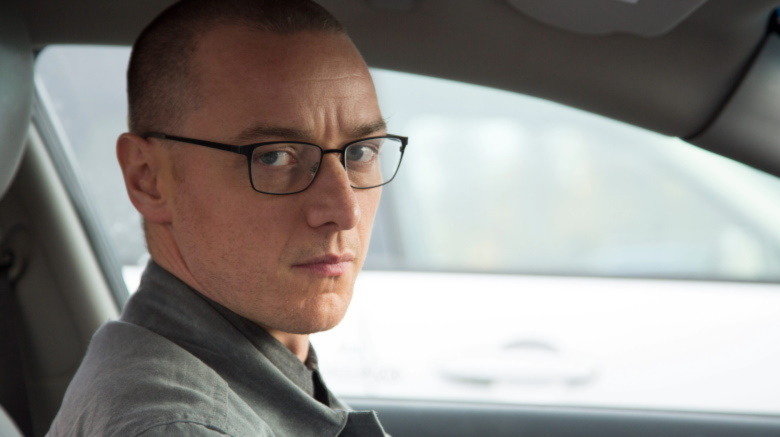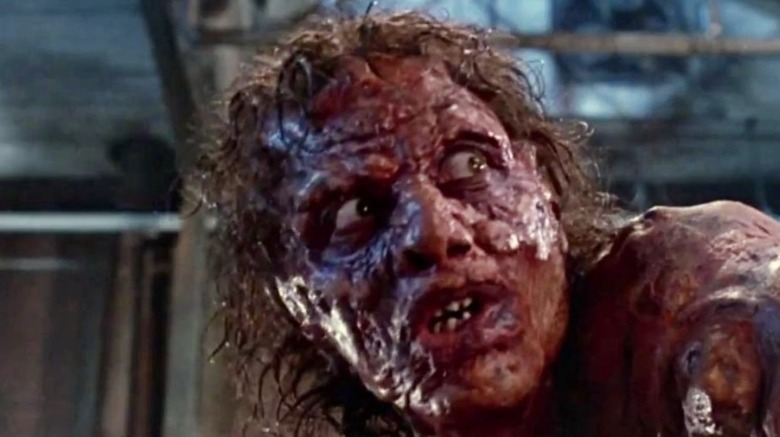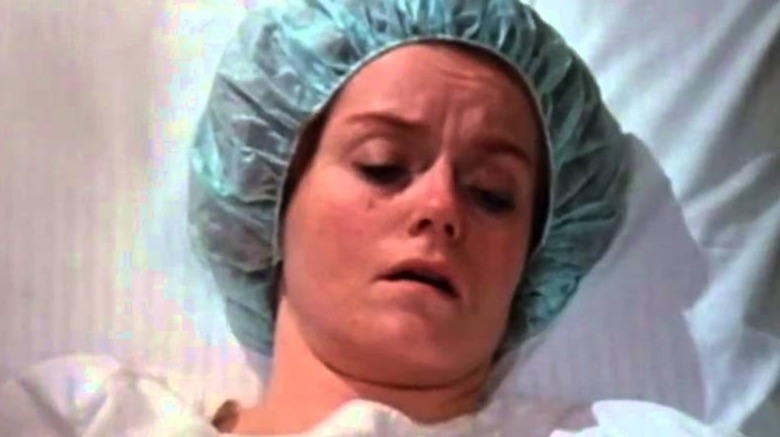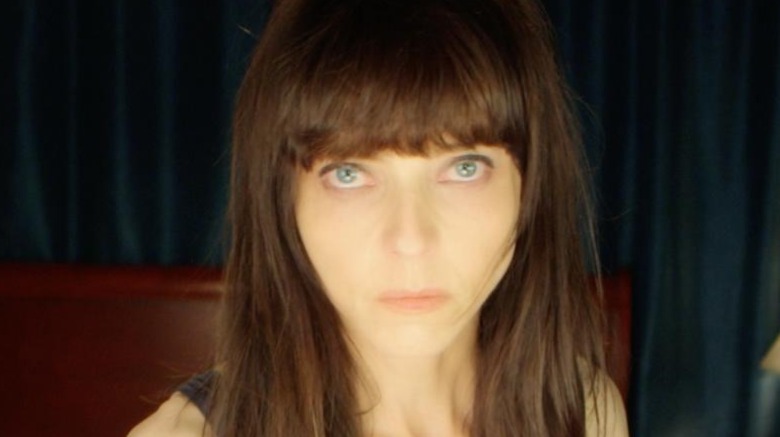The Best Monster Movies That Aren't Really About Monsters
At the core of every great monster movie is a metaphor that captures real-life struggle. "Frankenstein" is about the dangers of playing God. "The Wolf Man" explores our hidden animalistic urges. Even "Dr. Jekyll and Mr. Hyde" is essentially a story about drug addiction.
Sometimes, however, the metaphor takes center stage. The monster movie then becomes a powerful allegory about social injustice, human misery, or historical currents, given new significance through the horror movie tropes used. Such films invite multiple viewings, as audiences peel back its layers of meaning to face uncomfortable truths.
We're here to take a closer look at those horror films where the monster isn't just some computer-generated spectacle, but a twisted reflection of our own deep-rooted flaws. From a physical manifestation of nuclear war to a new embodiment of narcissism, these monsters are the living symbols of our traumas, insecurities, and prejudices — which just makes them that much scarier.
Godzilla brings the atomic bomb to life
"Godzilla Vs. Kong" (2021) celebrates the King of the Monsters' long history of battling other giant creatures. But Godzilla has a much darker origin: When "Godzilla" came out in 1954, the creature was nothing less than an overt metaphor for nuclear war. Japan endured two nuclear attacks during World War II, which devastated Hiroshima and Nagasaki. Thousands of people died from the initial blast, and thousands more died of radiation poisoning in the months and years following. In time, this tragedy also gave rise to a legendary movie monster.
An ancient prehistoric creature mutated by nuclear testing, Godzilla is, essentially, a living atomic bomb. Those who revisit the original film will see a movie that emphasizes the effects of Godzilla's rampage, rather than the action itself. People get vaporized by Godzilla's radioactive breath while others are crushed beneath falling debris. One of the most haunting sequences shows all the innocent people killed, maimed, and poisoned by Godzilla's attack, as a chorus of schoolchildren sing in the background.
While later films reimagine Godzilla as a protector of Earth, his initial appearance remains a haunting allegory, especially for a country that experienced the horrors of nuclear war firsthand. Both a figure of national catharsis as well as a reminder of real-life catastrophe, Godzilla's importance goes beyond mere entertainment.
Colossal explores domestic violence via kaiju battles
You don't normally hear the words, "giant kaiju monster movie" and "art film" used together in the same sentence, but this unconventional black comedy, once described as "'Godzilla' meets 'Lost in Translation,'" defies all genre conventions.
"Colossal" (2016) is the story of Gloria (Anne Hathaway), an out-of-work alcoholic writer who moves back to her hometown in New England. There, she reconnects with Oscar (Jason Sudeikis), a childhood friend who gives her a job at his bar. Naturally, this just makes Gloria's drinking problem worse, and Oscar turns out to be an abusive man intent on dominating Gloria's life.
Things take a weird turn when Gloria discovers her neighborhood playground allows her to manifest a giant kaiju monster in Seoul, South Korea, which mimics her movements. Even stranger, Oscar can manifest a giant robot in Seoul by doing the same thing. But where Gloria uses her avatar responsibly, Oscar uses his as another way to control Gloria, threatening to kill innocent people if she leaves him. Thus entrapped, Gloria must own her own power to break out of the cycle of abuse.
Flipping back and forth between epic monster battles and scenes between Gloria and Oscar, "Colossal" draws a unique link between domestic violence and giant monster fights. Seeing the abuse that often goes on behind closed doors displayed on a world stage enhances the grotesque horror of abuse and paints it in a disturbing new light.
Cloverfield focuses on surviving a disaster zone
Combining the "found footage" style of filmmaking made popular by independent films like "The Blair Witch Project" (1999) with big-budget kaiju movies, "Cloverfield" (2008) offers a horrifying man-on-the-street look at what it would be like to be stuck in a giant monster movie — or any major disaster. It starts innocently enough at a going-away party for a young man moving to Japan. But when a giant monster attacks the city, the clueless partygoers end up recording their journey of survival. Thus, they make their way through a landscape where buildings might topple down at any second, and senseless disasters threaten to kill them in an instant.
Unlike typical giant monster movies where the human players are members of the military or those with a close connection to the monster, "Cloverfield" forces the audience to witness the utter powerlessness of being an everyman caught in a disaster zone. None of these characters learn what the monster really is, and their uncertainty over what to do regularly causes them to place themselves in more danger.
Critics have drawn comparisons between "Cloverfield" and real-life disasters, such as the 9/11 terrorist attacks. Telling the story through gritty hand-held camera footage rather than the usual sweeping shots used in giant monster movies helps communicate the feelings of helplessness people endure during natural disasters or wartime attacks, making this movie feel disturbingly real.
A Monster Calls provides a bestial coping mechanism
Not all giant monsters manifest physically. Some only exist in the minds of their creators, yet still manage to make a major impact. Based on a book written by Patrick Ness (itself conceptualized by British writer Siobhan Dowd, who died of breast cancer before she could complete it), "A Monster Calls" (2016), follows 12-year-old Conor O'Malley (Lewis MacDougall) as he attempts to come to terms with his mother's terminal cancer.
To cope, Conor creates the imaginary "Monster" (Liam Neeson), who tells him stories and encourages him to act on his anger. While this results in some "monstrous" behavior (at one point, Conor trashes his grandmother's living room), it does help him deal with his trauma and accept the upsetting aspects of himself that he keeps hidden away. Ultimately, Conor realizes he's been manifesting an imaginary friend of his mother's, showing this particular monster may be real for more than just a single boy.
Imaginary friends have long been a popular trope in films, with some being friendly (Bing Bong in "Inside Out") and some very dangerous (Frank in "Donnie Darko"). In "A Monster Calls," the beast skirts the line between good and bad, showing that sometimes coping with trauma means accepting multiple sides of ourselves.
Pan's Labyrinth offers tests of character
Guillermo del Toro's films have a wonderful fairy tale-quality to them, of which "Pan's Labyrinth" (2006) is a fantastic example. Set in 1944 amidst a period of civil unrest in Francoist Spain, the story also takes place in a magical labyrinth that the lead character, Ofelia (Ivana Baquero), frequently visits.
When Ofelia meets a faun who believes she is the reincarnation of their Princess Moanna, Ofelia is offered a chance to gain immortality and return to her kingdom by completing three tasks. However, when she learns that one of her tasks requires her to harm her baby brother, she refuses. She is ultimately shot and killed in the real world, though her spirit manages to return to her magical realm.
Although the true nature of Princess Moanna's world remains ambiguous, the movie's theme of personal morality is very clear. Like many fairy tale monsters, the faun tests Ofelia's strength of character by giving her tasks that she considers immoral. By defying the faun, Ofelia proves her worth, earning her the right to reign as princess, even as her choice ends her mortal life.
Curse of the Cat People turns a monster into an imaginary friend
A sequel to the 1942 film "Cat People," "Curse of the Cat People" (1944) has since been recognized as its own exploration of childhood. The original film is a horror movie about Irena (Simone Simon), a woman who discovers she transforms into a savage panther-like creature when aroused. Although she tries to resist her animalistic urges for the sake of her new husband Oliver (Kent Reed), she ultimately succumbs, stalks Oliver's assistant Alice (Jane Randolph), and is killed in the film's final scenes.
"Curse of the Cat People" reveals Oliver and Alice married after Irena's death, and have a daughter, Amy (Ann Carter). When her parents prove neglectful and the neighborhood kids reject her, Amy comes across a photo of Irena and turns her into her imaginary friend. This unsettles her parents, who know who Irena really was, but Irena's "ghost" proves to be a friendly playmate and later reappears to help Amy narrowly escape death at the hands of a deranged woman.
When taken as a sequel, this movie may appear to offer a form of redemption for Irena. On its own, however, audiences have seen it as a study of how a sensitive child copes with the cruelties of the world. While the true nature of Irena's ghost remains ambiguous, her impact on Amy is very real.
A Quiet Place raises the stakes for parenting
In many ways, "A Quiet Place" (2018) is the ultimate suspense thriller. Its story, which centers around parents trying to survive attacks from blind monsters by teaching their kids to be as silent as possible, seems tailor-made for tense scenes. The film makes use of this by offering eerily quiet scenes punctuated by sudden loud noises, which alert the creatures and result in horrifying death.
But the film's set-up also makes it a perfect vehicle for exploring its main theme: The fears that come with modern parenting. While the movie's major threat to raising a family comes from the creatures, the monsters could represent literally any danger that parents want to keep their kids safe from. Director-writer-actor John Krasinski, who had his second daughter during the making of the film, has gone on record as stating the film is about family and "the extremes you go to as a parent to protect your kids."
Critics have also drawn parallels between the film's post-apocalyptic world and the political unrest that gripped America in 2018. While Krasinski admits this isn't what he was going for in the film, he celebrates the fact that audiences can use the film as a vehicle for deep discussion, showing that sometimes monster movies can hold multiple meanings.
Bird Box forces audiences to see a disturbing reality
"Bird Box" (2018) takes place in a post-apocalyptic world where mysterious demonic entities drive people who look at them to commit suicide. This causes people like lead character Malorie Hayes (Sandra Bullock) to blindfold themselves. Unfortunately, this doesn't spare anyone from seeing a wide variety of carnage, as people start killing themselves during seemingly routine activities like going for a hospital check-up or grocery shopping.
To survive, Malorie joins a community of blindfolded refugees and employs creative tactics to warn them about an incoming attack. This includes keeping pet birds, which go into hysterics in the presence of the entities (hence the movie title). However, not all of the survivors choose to wear blindfolds, creating schisms in the population and several dangerous situations.
Much like "A Quiet Place," "Bird Box" deals with themes of parenting, as Malorie is a new mother who actually gives birth during the film and attempts to keep her children safe. However, the movie also deals with multiple other themes, including disability: Survivors in this world need to learn how to navigate sightlessly, inviting discussions about disability and accessibility. Other critics have noted that the monsters represent a reality people try to deny by remaining blindfolded, creating societal schisms. Just as "A Quiet Place" uses silence to convey its themes, "Bird Box" uses sightlessness to offer multiple interpretations.
Split offers a skewed perspective on dissociative identity disorder
Kevin Wendell Crumb (James McAvoy) is a man with 23 different personalities, created as the result of the extreme abuse he suffered as a boy. When his own personality becomes submerged beneath his alternate personas, several of his other identities (collectively called "The Horde") kidnap three girls to use in a ritual that can unlock a 24th personality called "The Beast," who possibly possesses superhuman attributes.
While "Split" (2016) appears to explore a form of dissociative identity disorder (DID), it's encountered criticism from some within the mental health community who feel it stigmatizes people with DID as violent and dangerous. Critics emphasize that people with DID are rarely violent in real life and use their alternate personas as a way to survive trauma and cope with stressful situations. By creating a monster whose evil nature is associated with DID, advocates warn that the film stigmatizes DID and may discourage people struggling with it from seeking help.
McAvoy's performance was well-received by critics and audiences, however, and his character returned in the follow-up movie, "Glass" (2019), the third installment in Shyamalan's "Unbreakable" trilogy. Once more, Crumb (who displays even more alternate personas this time) is portrayed as a villain, although he's also manipulated by mastermind "Mr. Glass" (Samuel L. Jackson), who had a hand in creating him.
The Fly casts monsters as a disease
The original 1958 film "The Fly" is a creepy sci-fi thriller about a scientist who gets his head and arm swapped with a housefly during a botched teleportation experiment. David Cronenberg's 1986 remake reimagines the bizarre flick as a more gradual tale of body horror, which begins when Seth Brundle (Jeff Goldblum) gets his atoms merged with a fly. Initially, he comes out of the experiment seemingly unharmed, and, in fact, stronger and more energized.
Gradually, however, Seth's new genetic code begins to alter his body, causing parts of him to decay and fall apart. Seth himself initially believes he's suffering from a bizarre form of cancer, although he later learns his disease wants to transform him into a new form of life. Hoping to cure himself by merging his body with his girlfriend's (Geena Davis), Seth instead mutates into a more horrifying fly-human hybrid and ultimately suffers a mercy killing.
Seth's transformation resembles a form of leprosy, and he even wonders if he might be contagious. Some audiences also feel the movie is a metaphor for the AIDS epidemic of the 1980s. Cronenberg himself states he wasn't specifically alluding to AIDS when he made the film, but the movie's emphasis on body horror does make it easy for people to see it as a metaphor for multiple experiences with various debilitating diseases.
It's Alive places pharmaceutical companies in a harsh light
The pharmaceutical industry has come under public scrutiny for releasing dangerous drugs to the public. But in "It's Alive" (1974), drug companies produce literal monsters. After taking contraceptive pills for several years, Lenore Davis (Sharon Farrell) discovers the drugs have altered her body chemistry and caused her to give birth to a mutant baby who kills the delivery room staff after being born. Over the course of the film, however, we learn that the baby, although vicious, is not inherently evil. Like all infants, it's scared and reacts out of instinct, but it is capable of forming bonds with its parents.
While the baby is killed at the end of the movie, the pharmaceutical drugs that created it continue to wreak havoc. More mutant killer babies are born in "It Lives Again" (1978) and "It's Alive III: Island of the Alive" (1987). Like the original film, the latter movies continue to paint the drug companies (and the lawyers who argue for the babies' destruction) as the real monsters, although the mutant babies continue to be seen as a threat.
Although the special effects don't exactly hold up by modern-day standards, the mutant baby's design, created by special effects make-up legend Rick Baker, is extremely terrifying. Coupled with the sound effects that depict the baby simultaneously growling and crying, it's genuinely hard to know whether you feel sorry for the baby or scared of it — or both.
A Place Among the Dead exposes the vampire as the ultimate narcissist
Narcissism can express itself in different ways, but is characterized by the sufferer's need to have their sense of self validated by others. This can result in unhealthy relationships in which narcissistic abusers degrade victims, who often suffer psychological damage.
Seen in this light, narcissistic behavior is similar to the relationship vampires have with their victims. This inspired filmmaker Juliet Landau (Drusilla from "Buffy the Vampire Slayer") and her husband Deverill Weekes to produce "A Place Among the Dead" (2020), a vampire movie that links vampirism to narcissism. Landau plays Jules, a fictionalized version of herself who creates a documentary in which she tracks down a narcissistic serial killer who may or may not be a vampire. In the process, Jules' past experiences with abuse come up. The killer's true identity begins to seem like a moot point, since the psychological and physical damage he inflicts is very real.
Landau compares vampires to abusers, as they're both charismatic people who drain their victims to fill their own empty sense of self. She even compares the vampire's lack of a mirrored reflection to a narcissist's inability to self-reflect. In using vampires as a metaphor, "A Place Among the Dead" finds new psychological ground in a very old story.
